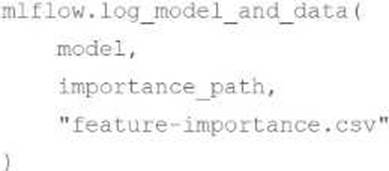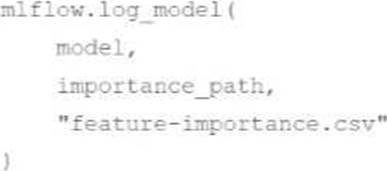Databricks Databricks Machine Learning Professional Databricks Certified Machine Learning Professional Online Training
Databricks Databricks Machine Learning Professional Online Training
The questions for Databricks Machine Learning Professional were last updated at Apr 27,2025.
- Exam Code: Databricks Machine Learning Professional
- Exam Name: Databricks Certified Machine Learning Professional
- Certification Provider: Databricks
- Latest update: Apr 27,2025
Which of the following describes concept drift?
- A . Concept drift is when there is a change in the distribution of an input variable
- B . Concept drift is when there is a change in the distribution of a target variable
- C . Concept drift is when there is a change in the relationship between input variables and target variables
- D . Concept drift is when there is a change in the distribution of the predicted target given by the model
- E . None of these describe Concept drift
Which of the following describes concept drift?
- A . Concept drift is when there is a change in the distribution of an input variable
- B . Concept drift is when there is a change in the distribution of a target variable
- C . Concept drift is when there is a change in the relationship between input variables and target variables
- D . Concept drift is when there is a change in the distribution of the predicted target given by the model
- E . None of these describe Concept drift
Which of the following tools can the machine learning engineer use to assess their theory?
- A . Kolmogorov-Smirnov (KS) test
- B . One-way Chi-squared Test
- C . Two-way Chi-squared Test
- D . Jenson-Shannon distance
- E . None of these
A data scientist is using MLflow to track their machine learning experiment. As a part of each MLflow run, they are performing hyperparameter tuning. The data scientist would like to have one parent run for the tuning process with a child run for each unique combination of hyperparameter values.
They are using the following code block:

The code block is not nesting the runs in MLflow as they expected.
Which of the following changes does the data scientist need to make to the above code block so that it successfully nests the child runs under the parent run in MLflow?
- A . Indent the child run blocks within the parent run block
- B . Add the nested=True argument to the parent run
- C . Remove the nested=True argument from the child runs
- D . Provide the same name to the run name parameter for all three run blocks
- E . Add the nested=True argument to the parent run and remove the nested=True arguments from the child runs
A machine learning engineer wants to log feature importance data from a CSV file at path importance_path with an MLflow run for model model.
Which of the following code blocks will accomplish this task inside of an existing MLflow run block?
- A .

- B .

- C . mlflow.log_data(importance_path, "feature-importance.csv")
- D . mlflow.log_artifact(importance_path, "feature-importance.csv")
- E . None of these code blocks tan accomplish the task.
Which of the following is a simple, low-cost method of monitoring numeric feature drift?
- A . Jensen-Shannon test
- B . Summary statistics trends
- C . Chi-squared test
- D . None of these can be used to monitor feature drift
- E . Kolmogorov-Smirnov (KS) test
A data scientist has developed a model to predict ice cream sales using the expected temperature and expected number of hours of sun in the day. However, the expected temperature is dropping beneath the range of the input variable on which the model was trained.
Which of the following types of drift is present in the above scenario?
- A . Label drift
- B . None of these
- C . Concept drift
- D . Prediction drift
- E . Feature drift
A data scientist wants to remove the star_rating column from the Delta table at the location path. To do this, they need to load in data and drop the star_rating column.
Which of the following code blocks accomplishes this task?
- A . spark.read.format(“delta”).load(path).drop(“star_rating”)
- B . spark.read.format(“delta”).table(path).drop(“star_rating”)
- C . Delta tables cannot be modified
- D . spark.read.table(path).drop(“star_rating”)
- E . spark.sql(“SELECT * EXCEPT star_rating FROM path”)
Which of the following operations in Feature Store Client fs can be used to return a Spark DataFrame of a data set associated with a Feature Store table?
- A . fs.create_table
- B . fs.write_table
- C . fs.get_table
- D . There is no way to accomplish this task with fs
- E . fs.read_table
Which of the following operations in Feature Store Client fs can be used to return a Spark DataFrame of a data set associated with a Feature Store table?
- A . fs.create_table
- B . fs.write_table
- C . fs.get_table
- D . There is no way to accomplish this task with fs
- E . fs.read_table
Latest Databricks Machine Learning Professional Dumps Valid Version with 60 Q&As
Latest And Valid Q&A | Instant Download | Once Fail, Full Refund

